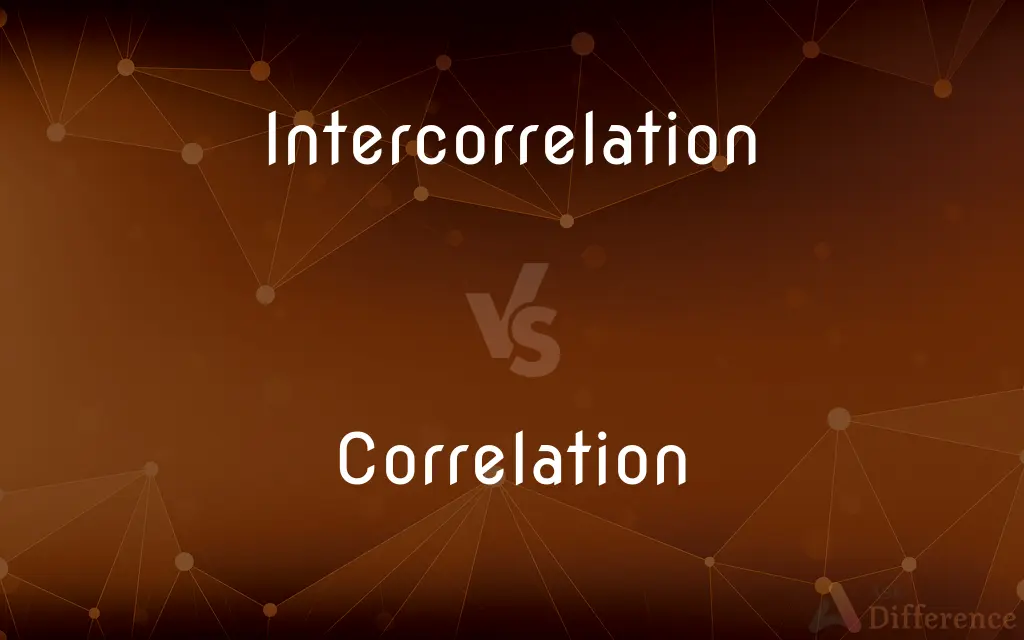Intercorrelation vs. Correlation — What's the Difference?
By Urooj Arif & Fiza Rafique — Updated on April 27, 2024
Intercorrelation refers to the mutual relationships among several variables, while correlation generally measures the relationship between two variables.

Difference Between Intercorrelation and Correlation
Table of Contents
ADVERTISEMENT
Key Differences
Intercorrelation is a specific type of correlation that examines the relationships among multiple variables simultaneously, particularly useful in multivariate statistical analyses. On the other hand, correlation typically refers to the relationship between just two variables, measuring how changes in one variable predict changes in another. In practical applications, intercorrelation is essential for understanding complex systems where multiple factors interact, whereas correlation provides insights into simpler, direct relationships.
When researchers study intercorrelation, they often use tools like correlation matrices or factor analysis to assess how various variables relate to one another within a larger dataset. In contrast, correlation analysis usually involves calculating a Pearson correlation coefficient or Spearman’s rank coefficient, which are measures of the strength and direction of a linear or monotonic relationship between two variables. The focus on intercorrelation can reveal underlying patterns that might not be apparent when only analyzing pairs of data, while standard correlation analysis might be sufficient for more straightforward questions.
The concept of intercorrelation becomes particularly valuable in fields like psychology or economics, where researchers are often interested in how multiple traits or factors co-vary. For example, studying the intercorrelations among various psychological traits can help in developing comprehensive personality profiles. On the other hand, correlation studies might look at the relationship between economic growth and unemployment rates, providing specific insights but not encompassing broader economic dynamics.
In statistical terms, understanding intercorrelations can help in the development of models that predict outcomes based on several input variables. This contrasts with correlation, which might primarily be used to validate hypotheses about the relationship between two specific variables. For instance, a complex predictive model in healthcare might require understanding intercorrelations among various patient metrics, whereas a simpler model might only need to know the correlation between treatment dosages and patient outcomes.
Intercorrelation analyses often lead to the identification of clusters or groups of variables that behave similarly, which can inform more effective interventions or strategies. Conversely, correlation analyses are typically used to confirm or deny the existence of a relationship, often as a preliminary step before more complex analyses.
ADVERTISEMENT
Comparison Chart
Definition
Examines relationships among multiple variables simultaneously
Measures the relationship between two variables
Statistical Tools
Correlation matrices, factor analysis
Pearson or Spearman coefficients
Focus
Multivariate relationships
Bivariate relationships
Application Fields
Psychology, economics, multivariate analysis
Any field, often used for simpler or preliminary analysis
Outcome
Identifies clusters or patterns among variables
Determines strength and direction of a linear relationship
Example Use
Developing comprehensive models in complex systems
Testing specific hypotheses between two variables
Compare with Definitions
Intercorrelation
Pertains to the interconnected nature of variable relationships.
Intercorrelation was crucial in understanding the multifaceted economic indicators.
Correlation
A measure of the relationship between two variables.
The correlation between smoking and lung cancer was strongly positive.
Intercorrelation
A matrix or table showing correlation coefficients among several variables.
The study presented an intercorrelation matrix of all factors influencing student success.
Correlation
Calculated as a correlation coefficient indicating direction and strength.
They reported a correlation coefficient of -0.89, indicating a strong inverse relationship.
Intercorrelation
Reflects a comprehensive approach to studying variable interactions.
Their research utilized intercorrelation to examine the broader market dynamics.
Correlation
Often a preliminary analysis before deeper investigations.
Initial correlation analysis suggested further study was warranted.
Intercorrelation
Used in multivariate statistical analysis to explore variable relationships.
Intercorrelation analysis revealed hidden influences among the variables.
Correlation
Fundamental in hypothesis testing in various research fields.
Researchers used correlation tests to investigate genetic influences on behavior.
Intercorrelation
Mutual correlation between three or more variables.
The intercorrelation among health metrics indicated complex underlying patterns.
Correlation
Can be positive (direct) or negative (inverse).
A positive correlation was found between exercise frequency and health.
Intercorrelation
Mutual correlation between multiple things
Correlation
In statistics, correlation or dependence is any statistical relationship, whether causal or not, between two random variables or bivariate data. In the broadest sense correlation is any statistical association, though it commonly refers to the degree to which a pair of variables are linearly related.
Correlation
A relationship or connection between two things based on co-occurrence or pattern of change
A correlation between drug abuse and crime.
Correlation
(Statistics) The tendency for two values or variables to change together, in either the same or opposite way
As cigarette smoking increases, so does the incidence of lung cancer, indicating a positive correlation.
Correlation
An act of correlating or the condition of being correlated.
Correlation
A reciprocal, parallel or complementary relationship between two or more comparable objects.
Correlation
(statistics) One of the several measures of the linear statistical relationship between two random variables, indicating both the strength and direction of the relationship.
Correlation
(algebra) An isomorphism from a projective space to the dual of a projective space, often to the dual of itself.
Correlation
Reciprocal relation; corresponding similarity or parallelism of relation or law; capacity of being converted into, or of giving place to, one another, under certain conditions; as, the correlation of forces, or of zymotic diseases.
Correlation
A reciprocal relation between two or more things
Correlation
A statistic representing how closely two variables co-vary; it can vary from -1 (perfect negative correlation) through 0 (no correlation) to +1 (perfect positive correlation);
What is the correlation between those two variables?
Correlation
A statistical relation between two or more variables such that systematic changes in the value of one variable are accompanied by systematic changes in the other
Common Curiosities
Can intercorrelation be applied to any field of study?
Yes, intercorrelation is applicable across various fields, especially where complex interactions between multiple factors are relevant.
Is intercorrelation always a better approach than simple correlation?
Not always; the choice between intercorrelation and simple correlation depends on the research question and the complexity of the dataset.
What statistical tools are used to measure intercorrelation?
Tools such as correlation matrices and factor analysis are commonly used to assess intercorrelation.
Can correlation coefficients be negative?
Yes, a negative correlation coefficient indicates an inverse relationship between two variables.
How does correlation analysis help in research?
Correlation analysis helps determine the direction and strength of the relationship between two variables, aiding in hypothesis testing.
What does a positive correlation indicate?
A positive correlation indicates that as one variable increases, the other variable also increases.
What is the main difference between intercorrelation and correlation?
Intercorrelation involves analyzing the relationships among multiple variables, whereas correlation typically involves just two variables.
How does understanding intercorrelation improve model accuracy?
By understanding how multiple variables interact, models can more accurately predict outcomes based on a wider range of inputs.
What is the significance of a correlation coefficient close to zero?
A coefficient close to zero suggests that there is no linear relationship between the two variables.
Why is factor analysis important in studying intercorrelation?
Factor analysis helps in reducing dimensionality and identifying latent factors that explain patterns in data involving multiple variables.
What role does correlation play in predictive analytics?
Correlation helps in identifying relationships that can be used to predict future trends or behaviors based on historical data.
Can intercorrelation reveal causation?
Like correlation, intercorrelation does not imply causation but can indicate patterns of association that might warrant further causal investigation.
How do researchers interpret complex intercorrelations?
Complex intercorrelations are interpreted through advanced statistical methods and domain-specific knowledge to understand interactions and influences among variables.
Is intercorrelation useful in machine learning?
Yes, understanding intercorrelations among features is crucial in machine learning for feature selection and building more accurate predictive models.
What does a correlation matrix reveal?
A correlation matrix provides a comprehensive view of the correlation coefficients between all pairs of variables in a dataset.
Share Your Discovery

Previous Comparison
Mist vs. Vapor
Next Comparison
Paste vs. PlasterAuthor Spotlight
Written by
Urooj ArifUrooj is a skilled content writer at Ask Difference, known for her exceptional ability to simplify complex topics into engaging and informative content. With a passion for research and a flair for clear, concise writing, she consistently delivers articles that resonate with our diverse audience.
Co-written by
Fiza RafiqueFiza Rafique is a skilled content writer at AskDifference.com, where she meticulously refines and enhances written pieces. Drawing from her vast editorial expertise, Fiza ensures clarity, accuracy, and precision in every article. Passionate about language, she continually seeks to elevate the quality of content for readers worldwide.














































